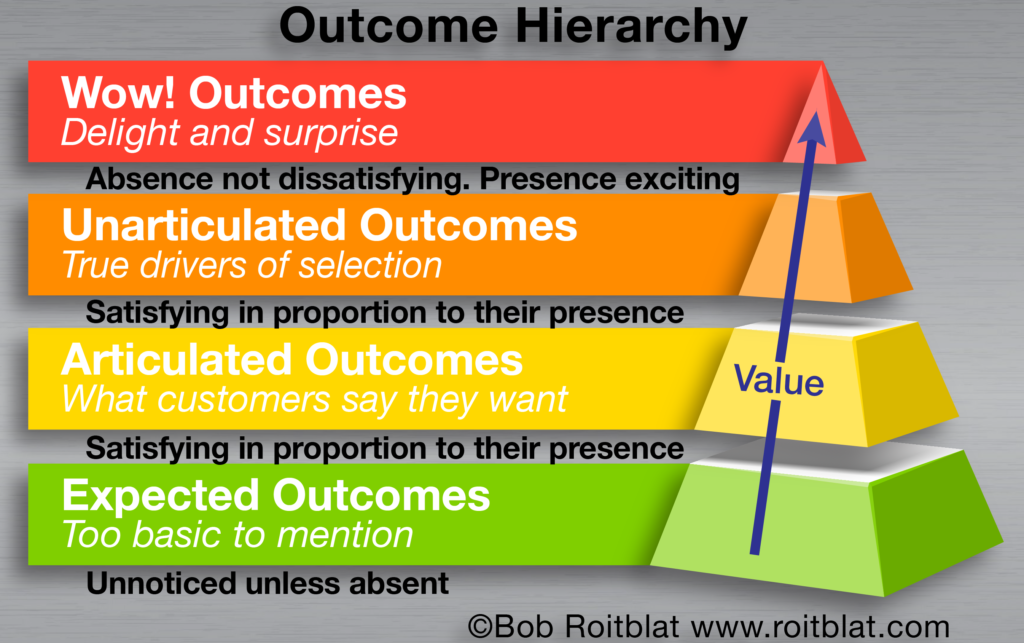Think of the last time you ordered a pizza for carry-out or delivery. Did you order a pizza or did you specifically order a hot pizza? When I’ve asked this question in my innovation workshops, 999 attendees out of a thousand say they just order a pizza. They expect it to come hot.
Expected Outcomes
Your customers also have similar expectations, such as your offering meeting their specifications, the availability of your products and services at an acceptable price, your offerings meeting regulatory compliance, your organization adhering to ethical standards and receiving good customer service.
If you only deliver outcomes that customers ask for, you may be disappointing your customers. These expected outcomes are often so basic that customers don’t bother to mention them.
Delivering expected outcomes often goes unnoticed by most customers, while their absence is very dissatisfying.
Articulated Outcomes
When you ask customers what they want they’ll tell you their Articulated Outcomes. Customers are fairly good at telling you what they think you want to hear, though customers often withhold vital information about their needs and objectives out of fear or distrust. If they do tell you something useful, they are probably also telling your competitors the same thing.
Customers are okay at telling you what they want today, based on currently available solutions. Rarely can customers fully articulate their own needs, at least not in as much detail as you would like.
Customers are often not consciously aware of what they really want, so they can’t tell you. They may also consider their needs so self-evident that they fail to mention them.
Customers have a hard time articulating what solution will satisfy their needs tomorrow—will produce their desired outcome tomorrow—if that solution doesn’t yet exist or they don’t believe it’s possible.
Creating solutions based exclusively on customers’ articulated outcomes is reactive and undifferentiated. Customer behavior is constantly evolving. Solutions designed to meet today’s challenges will be obsolete by the time they’re implemented. And your competitors are working on solving those same articulated needs.
When you develop solutions solely around customers’ articulated outcomes you miss opportunities for true differentiation.
Unarticulated Outcomes
By reaching beyond the obvious and understanding your customers’ needs more deeply than they can articulate, you identify opportunities to provide unique solutions that more fully deliver important yet unvoiced outcomes. It is only by first identifying unarticulated and unmet needs that you can offer clearly differentiated, premium-priced products and services.
Wow Outcomes
To truly delight and surprise your customers—and to leave your competition in the dust—deliver Wow Outcomes—Unarticulated Outcomes plus exceptional customer experience. Your customers will not be dissatisfied if you don’t deliver Wow Outcomes, but they’ll be thrilled and much harder to steal away when you do.
There is a potential unforeseen challenge with delivering Wow Outcomes: Yesterday’s wow outcome is today’s Expected Outcome. And today’s Wow Outcome is tomorrow’s Expected Outcome, which means that uncovering and delivering outcomes is a constantly moving target.
Purposeful Observation
How do you gain the insight needed to develop solutions that deliver Unarticulated and Wow Outcomes? The best way to gain insight into Unarticulated & Wow Outcomes is through Purposeful Observation– camping out with end-users, in their own environments, watching and recording them perform their daily tasks, habits, practices and behaviors while they interact with your products and services. Learning that is impossible to discover by any other means.
- Problem-solving produces an emotional benefit, not a financial one - March 18, 2022
- Innovation is about Solving Mysteries, not Puzzles - September 7, 2021
- Overcoming That’s the way we’ve always done it - August 3, 2021






